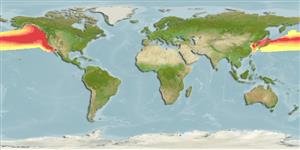>
Myctophiformes (Lanternfishes) >
Myctophidae (Lanternfishes) > Myctophinae
Etymology: Tarletonbeania: Because of Tarleton H. Bean, fisrt curator of fishes in Smithsonian Institut; 1846-1916; crenularis: From the Latin crenula which means small notch - referring to the slightly scalloped edges of the scale..
More on authors: Jordan & Gilbert.
Environment: milieu / climate zone / depth range / distribution range
Ecologia
marino batipelagico; distribuzione batimetrica 0 - 710 m (Ref. 6885). Deep-water; 66°N - 28°N
Eastern Pacific: southeastern Alaska to off Mexico, including the Gulf of Alaska and Bering Sea (Ref. 31442).
Size / Peso / Age
Maturity: Lm ? range ? - ? cm
Max length : 12.7 cm TL maschio/sesso non determinato; (Ref. 4925)
Short description
Morfologia | Morfometria
Spine dorsali (totale): 0; Raggi dorsali molli (totale): 11-14; Spine anali 0; Raggi anali molli: 17 - 20; Vertebre: 39 - 42. Adipose fin small, short based, and slender; pelvic fins with 8 or 9 rays, including rudimentary ray (Ref. 6885). Bright metallic blue dorsally, bright silvery ventrally (Ref. 6885). Branchiostegal rays: 8-9 (Ref. 31442).
Epipelagic to mesopelagic, found at the surface at night (Ref. 31442). Feed on euphausiids (Ref. 6885). Oviparous, with planktonic eggs and larvae (Ref. 31442). Lipid content is 2.1 % in fresh body weight and wax ester is, at the most, 5 % in total lipids (Ref. 9197).
Life cycle and mating behavior
Maturità | Riproduzione | Deposizione | Uova | Fecundity | Larve
Hart, J.L., 1973. Pacific fishes of Canada. Bull. Fish. Res. Board Can. 180:740 p. (Ref. 6885)
IUCN Red List Status (Ref. 130435)
Threat to humans
Harmless
Human uses
Informazioni ulteriori
Age/SizeAccrescimentoLength-weightLength-lengthLength-frequenciesMorfometriaMorfologiaLarveDinamica popolazioni larvaliReclutamentoAbbondanzaBRUVS
Strumenti
Special reports
Download XML
Fonti Internet
Estimates based on models
Preferred temperature (Ref.
123201): 1.8 - 9.3, mean 6.2 °C (based on 129 cells).
Phylogenetic diversity index (Ref.
82804): PD
50 = 0.7500 [Uniqueness, from 0.5 = low to 2.0 = high].
Bayesian length-weight: a=0.00871 (0.00387 - 0.01962), b=3.11 (2.92 - 3.30), in cm total length, based on LWR estimates for this (Sub)family-body shape (Ref.
93245).
Trophic level (Ref.
69278): 3.1 ±0.32 se; based on food items.
Resilienza (Ref.
120179): Alto, tempo minimo di raddoppiamento della popolazione meno di 15 mesi (Preliminary K or Fecundity.).
Fishing Vulnerability (Ref.
59153): Low vulnerability (10 of 100).
